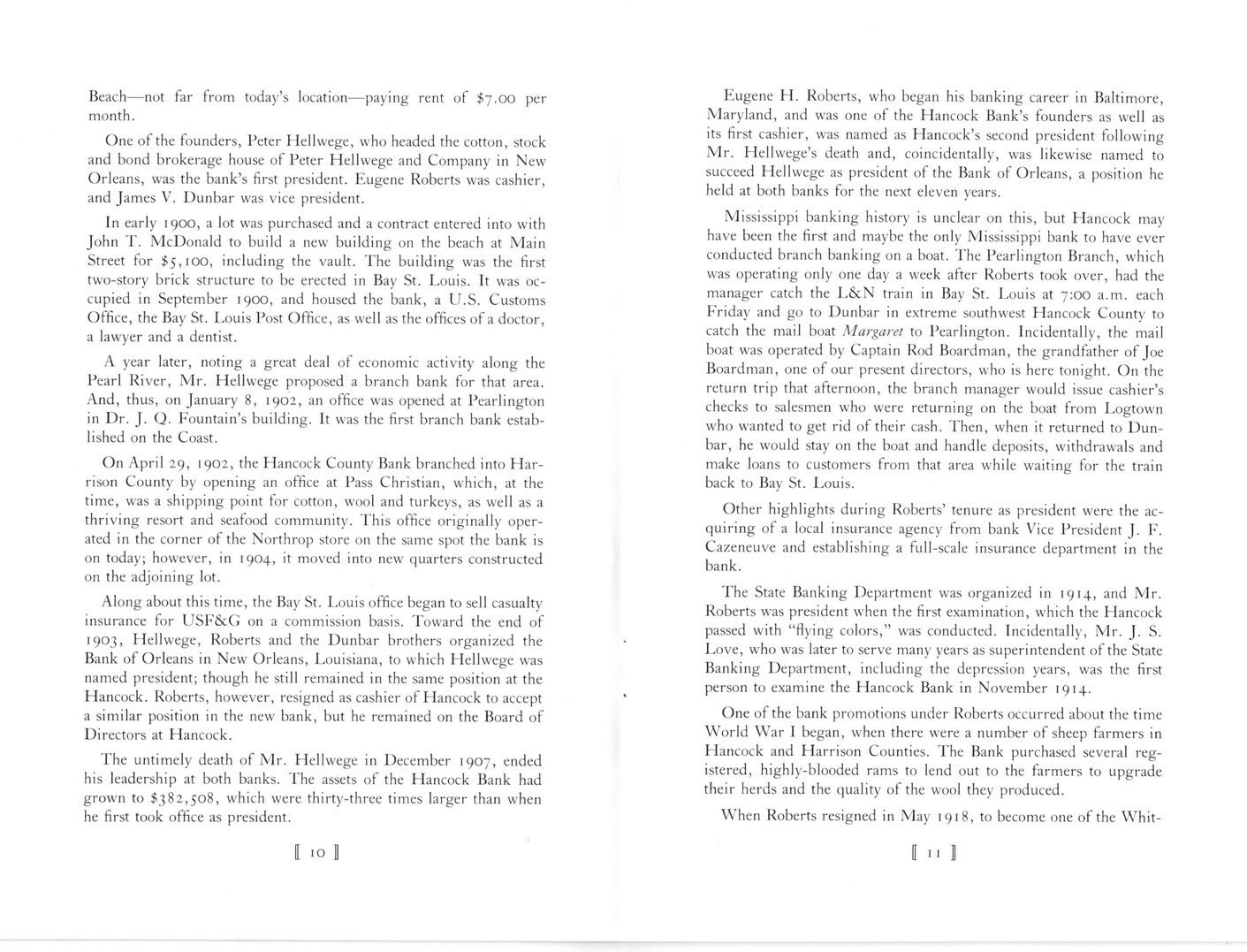This text was obtained via automated optical character recognition.
It has not been edited and may therefore contain several errors.
Beach—not far from today’s location—paying rent of $7.00 per month. One of the founders, Peter Hellwege, who headed the cotton, stock and bond brokerage house of Peter Hellwege and Company in New Orleans, was the bank’s first president. Eugene Roberts was cashier, and James V. Dunbar was vice president. In early 1900, a lot was purchased and a contract entered into with John T. McDonald to build a new' building on the beach at Main Street for $5,100, including the vault. The building was the first two-story brick structure to be erected in Bay St. Louis. It was occupied in September 1900, and housed the bank, a U.S. Customs Office, the Bay St. Louis Post Office, as well as the offices of a doctor, a lawyer and a dentist. A year later, noting a great deal of economic activity along the Pearl River, Mr. Hellwege proposed a branch bank for that area. And, thus, on January 8, 1902, an office was opened at Pearlington in Dr. J. Q. Fountain’s building. It was the first branch bank established on the Coast. On April 29, 1902, the Hancock County Bank branched into Harrison County by opening an office at Pass Christian, which, at the time, was a shipping point for cotton, wool and turkeys, as well as a thriving resort and seafood community. This office originally operated in the corner of the Northrop store on the same spot the bank is on today; however, in 1904, it moved into new quarters constructed on the adjoining lot. Along about this time, the Bay St. Louis office began to sell casualty insurance for USF&G on a commission basis. Toward the end of 1903, Hellwege, Roberts and the Dunbar brothers organized the Bank of Orleans in New Orleans, Louisiana, to which Hellwege was named president; though he still remained in the same position at the Hancock. Roberts, however, resigned as cashier of Hancock to accept a similar position in the new bank, but he remained on the Board of Directors at Hancock. The untimely death of Mr. Hellwege in December 1907, ended his leadership at both banks. The assets of the Hancock Bank had grow'n to $382,508, which were thirty-three times larger than when he first took office as president. Eugene H. Roberts, who began his banking career in Baltimore, Maryland, and w'as one of the Hancock Bank’s founders as well as its first cashier, was named as Hancock’s second president following Mr. Hellwege’s death and, coincidentally, was likewise named to succeed Hellwege as president of the Bank of Orleans, a position he held at both banks for the next eleven years. Mississippi banking history is unclear on this, but Hancock may have been the first and maybe the only Mississippi bank to have ever conducted branch banking on a boat. The Pearlington Branch, which was operating only one day a week after Roberts took over, had the manager catch the L&N train in Bay St. Louis at 7:00 a.m. each Friday and go to Dunbar in extreme southwest Hancock County to catch the mail boat Margaret to Pearlington. Incidentally, the mail boat was operated by Captain Rod Boardman, the grandfather of Joe Boardman, one of our present directors, who is here tonight. On the return trip that afternoon, the branch manager would issue cashier’s checks to salesmen who were returning on the boat from I.ogtown who wanted to get rid of their cash. Then, when it returned to Dunbar, he would stay on the boat and handle deposits, withdrawals and make loans to customers from that area while waiting for the train back to Bay St. Louis. Other highlights during Roberts’ tenure as president were the acquiring of a local insurance agency from bank Vice President J. F. Cazeneuve and establishing a full-scale insurance department in the bank. The State Banking Department was organized in 1914, and Mr. Roberts was president when the first examination, which the Hancock passed with “flying colors,” was conducted. Incidentally, Mr. J. S. Love, who was later to serve many years as superintendent of the State Banking Department, including the depression years, was the first person to examine the Hancock Bank in November 1914. One of the bank promotions under Roberts occurred about the time World War I began, when there were a number of sheep farmers in Hancock and Harrison Counties. The Bank purchased several registered, highly-blooded rams to lend out to the farmers to upgrade their herds and the quality of the wool they produced. W'hen Roberts resigned in May 1918, to become one of the Whit-

Hancock Bank Leo-Seal-Leading-The-Way-(1987)-06